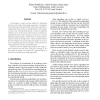28 search results - page 1 / 6 » MultiSeq: unifying sequence and structure data for evolution... |
BMCBI
2006
13 years 7 months ago
2006
Background: Since the publication of the first draft of the human genome in 2000, bioinformatic data have been accumulating at an overwhelming pace. Currently, more than 3 million...
TCBB
2010
13 years 5 months ago
2010
— We describe a theoretical unifying framework to express comparison of RNA structures, which we call alignment hierarchy. This framework relies on the definition of common supe...
TPDS
1998
13 years 7 months ago
1998
—A massive volume of biological sequence data is available in over 36 different databases worldwide, including the sequence data generated by the Human Genome project. These data...
CVPR
1997
IEEE
14 years 9 months ago
1997
IEEE
In this paper a novel recursive method for estimating structure and motion from image sequences is presented. The novelty lies in the fact that the output of the algorithm is inde...
BMCBI
2010
13 years 7 months ago
2010
Background: Sequence alignments form part of many investigations in molecular biology, including the determination of phylogenetic relationships, the prediction of protein structu...

